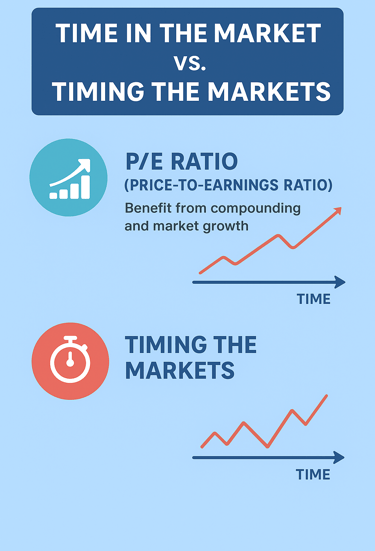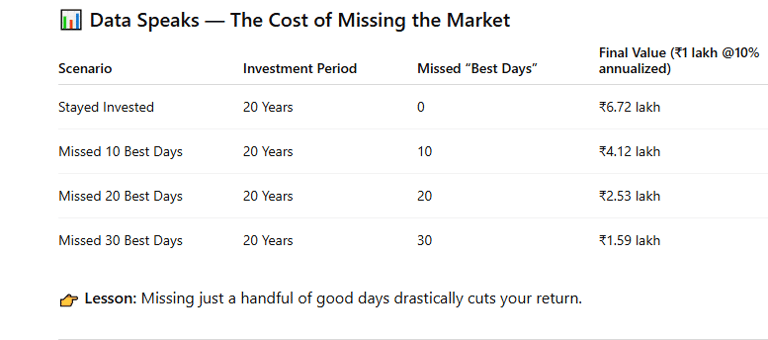Time in the Market vs. Timing the Market — The Truth Every Investor Should Know
Is long-term investing more profitable than trying to time the market? Learn the real difference between “time in the market” and “timing the market,” and discover which strategy truly builds lasting wealth.
RAVINDRA PRAJAPATI (EDUCATIONAL BLOG)
10/8/20252 min read


Introduction: The Great Investor’s Dilemma
Every investor has asked this at some point:
“Should I stay invested for the long run, or try to buy low and sell high?”
It’s the ultimate financial debate — Time in the Market vs. Timing the Market.
While one strategy relies on patience and consistency, the other depends on prediction and precision. Both sound tempting, but only one stands the test of time.
Let’s uncover the truth behind which approach really wins and why.
What Does “Time in the Market” Mean?
Time in the market refers to staying invested over long periods — regardless of market ups and downs.
This strategy believes in the power of compounding — letting your money grow exponentially as your returns begin earning returns of their own.
Key Principles
Focus on long-term wealth creation
Regular investments (like SIPs)
Ignore short-term noise
Trust the power of time and patience
Example
Imagine you invested ₹1 lakh in Nifty 50 in 2010.
By 2025, that investment would have multiplied multiple times, despite several market crashes — because you stayed invested.
The longer you stay, the higher your chances of benefiting from overall market growth.
What Is “Timing the Market”?
Timing the market means trying to predict market highs and lows — buying at the bottom and selling at the top.
In theory, it sounds like the smartest way to invest.
In reality, even experts and fund managers struggle to do it consistently.
Why It Fails Often
Markets are unpredictable
Emotions (fear & greed) drive wrong decisions
Missing a few “best days” can destroy returns
Example
According to studies, missing just the 10 best days in the market over 20 years can reduce your total returns by nearly 50%.
And guess when those “best days” happen? — Usually right after big crashes, when most people panic and sell!
The Power of Compounding: The Time Advantage
Let’s say two investors start with ₹1 lakh at 12% annual growth.
Investor A stays invested for 20 years → ends with ₹9.6 lakh
Investor B jumps in and out, missing a few best days → ends with ₹5.4 lakh
Time doubled the wealth — not timing!
Compounding rewards discipline, not perfection.


The Balanced Approach: Discipline Over Prediction
You don’t have to pick one extreme. Smart investors blend both ideas:
Stay Invested, But Stay Aware
Keep your long-term portfolio invested
Review allocation annually
Rebalance, but don’t react emotionally
Follow the Process, Not the Noise
Automate SIPs
Focus on fundamentals, not headlines
Remember — volatility is temporary, growth is permanent
Conclusion: Time Wins Every Time
Timing might look exciting, but time in the market is what builds real wealth.
Because markets reward patience, not panic.
The truth is simple:
“It’s not about when you invest — it’s about how long you stay invested.”
So, the next time markets fall, don’t rush out — stay calm, stay invested, and let time do the heavy lifting.
Key To Remember:
Compounding grows money quietly in the background.
Missing the market’s best days can destroy returns.
The secret? Consistency > Prediction.
Key tags:
#FinanceEducation #InvestSmart #Compounding #TimingTheMarket #StockMarketIndia #FinancialLiteracy #InvestingBasics #WealthCreation #SIPInvesting
RAVINDRA PRAJAPATI, Not a sebi registered
FOLLOW Us
ravindra.prajapati1122@gmail.com
+91 9795187745
© 2025. PiPiFinTech All rights reserved.
Contact Us
ABOUT Us
Our mission is to empower you to maximize every single penny and best solution for wealth generation and management for every mature age group.
Product TOPICS
Digital E-Wealth Platform
Mutual Funds
Education Planning
Insurance
FD and Bonds
Retirement Planning
Wealth Creation
(Disclaimers : Mutual Fund investments are subject to market risks, please read scheme related documents carefully.)
